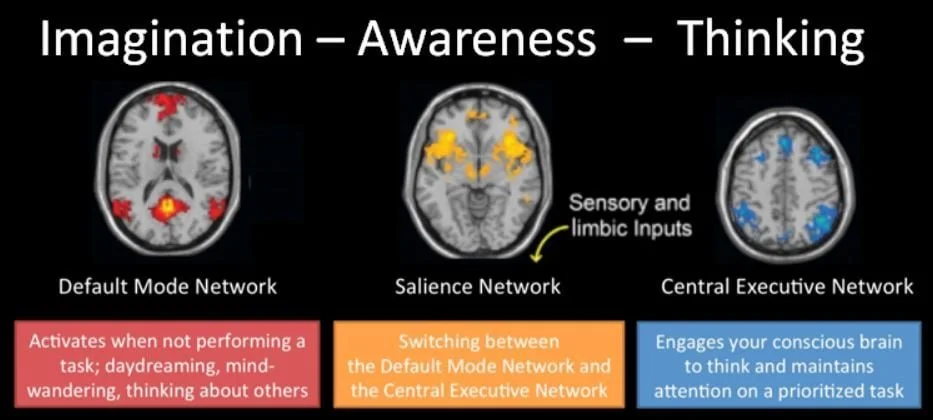Balance your 3 main brain networks: thinking - awareness - imagination
Brain Network Theory:
Although there are dozens of recognized networks (a cluster of interconnected structures that carry out specific functions to navigate you through life), the three most researched ones that involve cognition, creativity, and emotional regulation are the Default Mode Network (DMN), the Salience Network (SN), and the Central Executive Network (CEN). Here's a brief summary of terms you'll be hearing a lot about very soon:
DMN: Imagination:
Originally called the “resting state” of the brain when no specific activity was consciously being carried out, the DMN is considered the center of imagination, intuitive problem-solving, and daydreaming (a semi-conscious state of mind-wandering). Key nodes include the medial prefrontal cortex (mPFC), the posterior cingulate cortex (PCC), and the precuneus, part of the parietal lobe. Other researchers like Kaufman, Carroll, and Seligman, prefer to call the DMN network the “Imagination Network.” Other recent researchers have followed suit. Many psychological dysfunctions are associated with over-activity and under-activity of the DMN. This suggests that many forms of anxiety are actually imaginary scenarios about the future based on past experiences stored in long-term memory.
CEN: Thinking:
This network contains many cognitive processes that include language and communication skills and the CONSCIOUS ability to analyze, judge, and decide and plan what actions to take to accomplish goals and satisfy specific desires. It also plays a key role managing emotions, adapting to environmental and internal changes, and forming new behaviors that can override older ones. Key nodes include the dorsolateral prefrontal cortex (DLPFC) and the posterior parietal lobe, but it is mainly the DLPFC where we CONSCIOUSLY recall memories and evaluate how to take CONSCIOUS action in the world. When a person consciously obsesses on negative memories and/or negative thoughts and fantasies associated with the DMN, this contributes to, and reinforces, a wide range of cognitive and emotional problems.
SN: Awareness:
This network has been identified as the key area that regulates the functioning of the CEN and DMN and the feeling/emotional networks in the limbic regions. It is associated with empathy, compassion, mood regulation, moral decision-making, and self- and social-awareness. It detects salient stimuli and assigns a value on the importance of different experiences and actions, and it is also stimulated when cognitive and emotional incongruities occur. The two key nodes are the anterior cingulate and the insula and possibly the amygdala and nucleus accumbens. Self-reflective and contemplative practices like mindfulness have been shown to stimulate the 2 key nodes in a way that allows us to be partially AWARE of the CEN and DMN processes in a way that appears to influence their functioning and the functioning of the other networks mentioned below.
A Motivation/Reward Network, a Memory Consolidation Network, and several Emotional Networks identified by Panksepp have also been proposed by neuroscience researchers that can be indirectly influenced by our CONSCIOUS thoughts and behavior and our ability to increase AWARENESS of internal cognitive and emotional states through the practice of brief mindfulness exercises.





